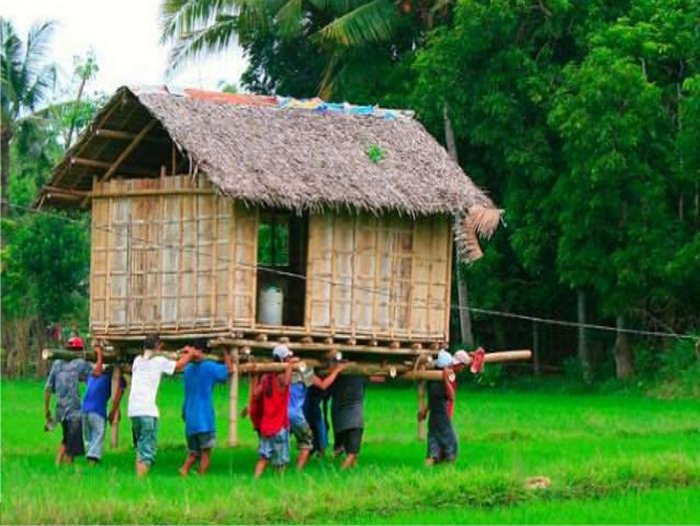MessageToEagle.com – The ancient Bayanihan tradition of the Filipino people is a true sign of good ‘community spirit’ and shows Filipinos’ concept of helping one another most especially in times of need without expecting anything in return.
According to this custom villagers help someone relocate by lifting up their entire house and moving it somewhere else. When we say entire house, we mean really the whole house, including its walls and roof.
It sounds like a tremendous effort, but the traditional Filipino house, the ‘bahay-kubo’, can be moved using wooden poles which are carried from the old place to the new one.

The ‘bahay-kubo’ house is not very heavy which means that a group of people can lift and carry it on their shoulders. The relocation does not only involve moving the family’s personal belongings but most importantly it concerns the transfer of the family’s entire house to a new location.
Able-bodied men usually participated in such feats, while women stood and watched, casually chatting and cheering the men on. Afterwards, there was a small gathering as a form of celebration and socialization. The Bayanihan tradition was practiced when people wish to move locations in the rural area. This was done for several reasons but mainly to avoid impending floods or landslides.
See also:
Mysterious Ancient Tradition Of ‘Hanging Coffins’
The Kitchen Gods Return To The Heavens – Ancient Vietnamese Tradition Is Still Alive
The Little Known Ancient History Of Wedding Gifts
The Bayanihan derived from a Filipino word “bayan”, which means nation, town or community. The term bayanihan itself literally means “being in a bayan”, which refers to the spirit of communal unity, work and cooperation to achieve a particular goal.
The Bayanihan spirit is still alive, at least to some extent. There are still people in rural areas that transfer their house into another place and people still help. Unfortunately, the Bayanihan tradition is slowly dying out. It is not practiced as frequently as before.
This is mainly due to the change of environment, from wooden slit-houses to concrete infrastructures. The rural areas have adapted more and more to the urban jungles. People’s attitudes and disposition have also changed. Those who want to keep the ancient Bayanihan tradition alive complain modern people are selfish and it becomes harder and harder to create and sustain group efforts.
MessageToEagle.com







